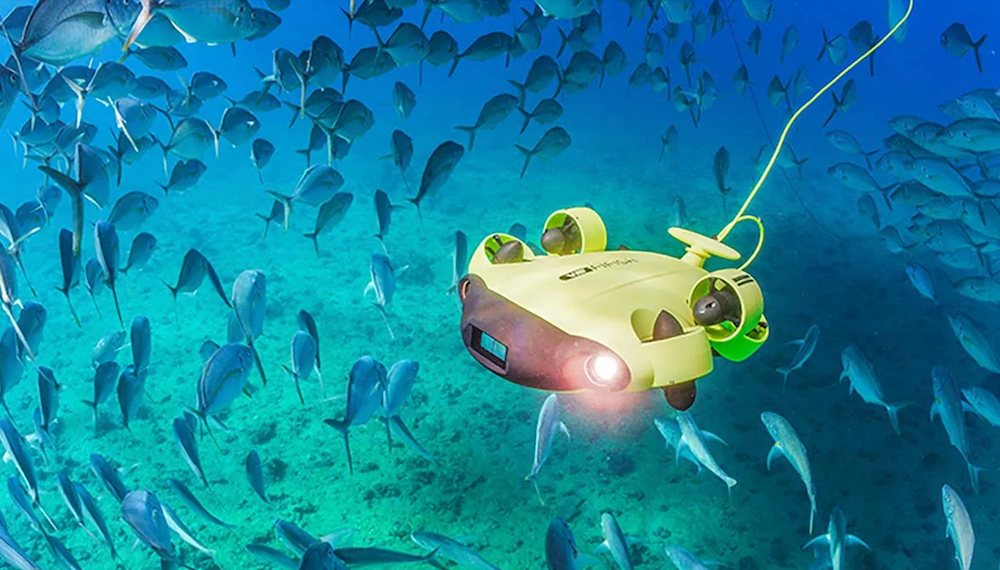Underwater drones, also known as submersible drones or remotely operated vehicles (ROVs), are revolutionizing marine exploration and research. These advanced technological marvels have made it possible to explore the depths of the ocean, offering unparalleled insights into underwater ecosystems, structures, and more. Whether it’s for scientific research, industrial applications, or recreational use, underwater drones are transforming the way we interact with aquatic environments.
A Brief History of Underwater Drones
The concept of underwater exploration dates back to ancient times, but the advent of underwater drones didn’t occur until the 20th century. The first ROVs emerged in the 1950s as tools for military and scientific applications, primarily in deep-sea exploration. These initial models were tethered to surface vessels and were used to explore shipwrecks, underwater oil rigs, and other submerged structures.
The technology continued to evolve in the 1980s, when the development of remotely operated vehicles (ROVs) became more mainstream for commercial and industrial purposes. Over time, these devices became smaller, more efficient, and increasingly autonomous. The introduction of unmanned vehicles (UVs) opened the door to personal, recreational use, allowing enthusiasts to explore the ocean without the need for professional equipment or diving experience.
How Do Underwater Drones Work?
Underwater drones rely on a combination of advanced sensors, cameras, and propulsion systems to navigate underwater environments. Here’s a basic breakdown of how they operate:
- Propulsion System
Underwater drones are equipped with powerful thrusters or propellers that help them move through water. These thrusters allow the drone to move in various directions, including forward, backward, and rotate 360 degrees. - Communication System
Unlike aerial drones, which communicate via radio signals, underwater drones use acoustic communication. This involves the transmission of sound waves, which can travel long distances through water and allow the drone to send data back to the operator or surface vehicle. - Sensors and Cameras
Modern underwater drones come with high-definition cameras and a range of sensors, including depth sensors, temperature gauges, and sonar. These sensors collect data and feed it back to the drone’s operator, allowing for accurate measurements and a detailed view of the underwater environment. - Battery and Power Supply
Underwater drones rely on high-capacity batteries that can provide extended operational times. Depending on the drone’s power source and the application, these drones can stay submerged for hours, performing tasks such as inspection, mapping, or video recording. - Navigation and Control
Most underwater drones are equipped with GPS and other navigation technologies. These allow them to follow pre-set paths or be manually controlled by the operator. In more advanced models, the drones may be able to operate autonomously using AI and pre-programmed mission profiles.
Specifications of Underwater Drones
The specifications of underwater drones can vary based on their intended use, but most modern models share a few common features. Here are the key specifications you might find in underwater drones:
- Depth Range
One of the most critical specifications is the maximum depth the drone can reach. While most consumer models are rated for depths of 100 to 300 meters, professional models used for industrial or research purposes can reach depths of over 6,000 meters, suitable for deep-sea exploration. - Camera Quality
Underwater drones are typically equipped with 4K or HD cameras that provide real-time video feeds. These cameras may include pan and tilt features to capture footage from multiple angles. - Battery Life
The battery life of an underwater drone is essential for its performance. Most drones have a battery life of 2 to 10 hours, depending on factors such as water conditions, the weight of the drone, and the size of the battery. - Size and Weight
The size and weight of underwater drones vary based on their features and capabilities. Consumer models are generally lightweight and portable, weighing around 1 to 3 kg. In contrast, industrial models may weigh several hundred kilograms. - Payload Capacity
Some underwater drones come with payload capacities that allow them to carry additional sensors or tools, such as sonar systems or sampling devices. Payload capacity varies from 2 kg to over 10 kg for commercial models. - Thrusters and Propulsion
Most underwater drones come equipped with 4 to 6 thrusters that allow for versatile movement, including vertical and horizontal mobility. These thrusters enable precise maneuvering, even in strong currents.
Why Use an Underwater Drone?
The use of underwater drones has exploded in recent years, particularly in fields such as marine biology, underwater archaeology, oil and gas exploration, and even recreational diving. Here’s why they are essential:
- Cost-Effective Exploration
Underwater drones provide a far more cost-effective solution to underwater exploration compared to manned submersibles or diving operations. They can reach depths and locations that would otherwise be inaccessible, and without the risk of human life. - Safety
Underwater drones eliminate the need for human divers to perform dangerous tasks in risky environments, such as inspecting deep-sea oil rigs or exploring shipwrecks. - Ease of Use
Modern underwater drones are user-friendly and designed for both professionals and hobbyists. Many are equipped with easy-to-use interfaces and can be controlled via smartphones or tablets. - Increased Efficiency
These drones offer enhanced operational efficiency, reducing the need for lengthy planning, expensive equipment, and long-duration human labor. - Environmental Monitoring
With their ability to reach remote and difficult-to-access locations, underwater drones play a critical role in monitoring marine ecosystems, tracking climate change, and collecting data on ocean pollution.
Applications of Underwater Drones
The applications for underwater drones are vast and varied, including:
- Marine Research
Scientists use underwater drones to study marine life, ecosystems, and underwater geology. These drones can capture high-quality imagery and perform water quality analysis. - Underwater Inspections
The oil and gas industry, as well as shipping and maritime sectors, use underwater drones for inspecting pipelines, oil rigs, and submerged structures to ensure safety and maintenance. - Archaeology and Exploration
Underwater drones are also used to explore shipwrecks, submerged cities, and other historical sites, providing valuable data for archaeologists and historians. - Search and Rescue
Underwater drones are deployed in search-and-rescue operations to locate missing persons in bodies of water, as well as to recover objects from the ocean floor.
Conclusion
Underwater drones represent a breakthrough in marine technology, making underwater exploration safer, more efficient, and more accessible than ever before. Their ability to operate in deep, challenging environments while providing high-quality data is revolutionizing various industries, including marine biology, archaeology, and industrial inspections.
As the technology continues to advance, the potential applications of underwater drones will only continue to grow, offering exciting opportunities for exploration and research. Whether you are a professional or a hobbyist, understanding the capabilities, specifications, and benefits of underwater drones is essential for harnessing their full potential.












